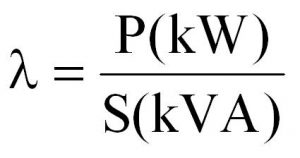What is “Power Factor”?
The definition of “Power Factor” relies on the definitions of “active power” and “apparent power”.
In an electrical circuit, the active power P is the real power transmitted to loads such as motors, lamps, heaters, computers … The electrical active power is transformed into mechanical power, heat or light.
The physical unit for the active power is one watt (W), with one kilowatt (kW) often used for commodity.
In a circuit where the applied r.m.s. voltage is Vrms and the circulating r.m.s. current is Irms, the apparent power S is the product Vrms x Irms.
The apparent power is then the basis for electrical equipment rating. One piece of electrical equipment (transformer, cable, switch …) must be designed in relation to the r.m.s. values of voltage and current.
The physical unit for the apparent power is one volt-ampere (VA), with one kilovolt-ampere (kVA) often used for commodity.
The Power Factor is the ratio of the active power P (kW) to the apparent power S (kVA) for a given circuit.
For the special case of sinusoidal voltage and current with a phase angle “phi”, the Power Factor is equal to cos(phi) , called Displacement Power Factor (DPF).
Jacques Schonek

power is the cosin of the angle of displacement between voltage and current . It does not apply to a pure resistive circuit
How to increase power factor from 0.55 to 1.0 at 150 kw load.
THER ARE VARIOUS EQUIPMENTS R DEVICES THT CAN BE USED TO IMPROVE THE PF OF A SYSTEM…. A CAPACITOR IS AN EXAMPLE OF A PF IMPROVEMENT DEVICE…THER ARE MOTORS USED TOO 4 THIS PURPOSE…. BT 4 A LARGER SYSTEM….
Ian desirous of knowing and actually working to deliver power factor improvement package to many end users. Can you heip?
As I undrestand that Power factor means that Power factor of system/apparatus. say system,
power factor of system is ratio between from source, power given to the system(apparant power) and power converted from the system(active power).
This because of due to presence of energy storing elements in the system, the given power is not fully converted from the system and some amount of the power(reactive power) is returned to the source
power factor is nothing but the difference of angle between current and voltage….
I just purchased an energy saving device off Ebay. I had heard of the KVAR brand units but when I surfed the web and called the company, I couldn’t get specs for the product. So I went to Ebay and I ordered a unit out of Honk Kong with advertised good specs if you can believe what is stated on Ebay. The unit looks as good as any but on careful inspection after receipt, I noted it didn’t say where it was made. I decided to open the box to see how the electronics were configured and I was surprised by the simplicity of the device. It was clear to me that I would see a two capacitor device but I expected a circuit board with overload… What I found appears to be two capacitors hooked to a monitor light for the front of the box attached by a variety of wires and nothing else. I have pictures for your review if they will help. Here is what is advertised for specs that I have doubt the box will do but I don’t want to confront the seller or Ebay without a second and third reliable opinion.
Advertised specs that I don’t see how are possible ( full list can be posted upon request ):
1. double insulated
2. Surge Suppression – 6500 Joules
3. Let Through Voltage – 150V Line-To-Neutral
4. Spike Protector: Utility Spike And Electrical / Lightning Storms
5. Transient Noise Reduction: MOV (Metal Oxide Varistor)
6. … Thermal & Overload Protection
here is just a start of my concern: it says double insulated. There are three wires for the 220/240 VAC installation ( two red and one green wire ). As you would expect, one red wire goes to each 120vac leg of your electric panel and the green goes to the ground bus. Well in the box, the green wire comes into the all metal box and goes to a bolt that hold a flat metal crush clap over the two caps. So, when you look at #3 above to read 150V line to neutral, one would think that if the transient voltage stays too long over 150VAc on one of the legs, that energy will be diverted to the ground wire to protect what you have plugged in within your home. But as you can see, with the way it is designed, if that ground wire does not make a good contact with the home’s ground bus then the exterior of the box could be hot. But I don’t see how #3 is possible anyway with no circuit board to clap the voltage to the 150vac to start. So, how could this unit be double insulated? I need an elect engineers opinion so I know if I am looking at this list correctly. With no circuit board or other discrete component- where is the MOV of # 5 or how is #6 possible?
It’s a shame you don’t have a donate button! I’d without a doubt donate to this excellent blog! I guess for now i’ll settle for book-marking and adding your RSS feed to my Google account.
I look forward to brand new updates and will talk about
this website with my Facebook group. Chat soon!
My blog post Cathern
This formula is very useful, helping me to calculate the power consumption of electrical appliances in the house.
Thank you very much